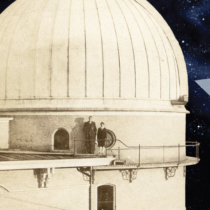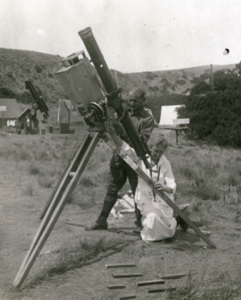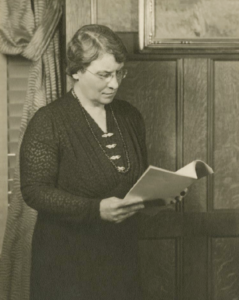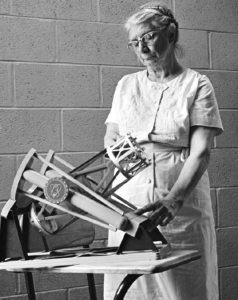Magazine

Reaching for the Stars
It was still very much a man’s world in the United States during the late 1800s and early 1900s. Increasingly, though, women looked beyond the “man’s world” and explored the universe instead. At U-M, the work of some early women astronomers was centered at the Detroit Observatory. From this vantage point, they looked skyward and created a better understanding of solar flares, comets, the moon, the stars, and all that could be seen through the observatory’s mighty telescopes. These pioneering women left a legacy that is as big as the cosmos itself.
By Katie Vloet
Helen Dodson Prince
Helen Dodson Prince chose solar flares as her primary field of study, and it’s easy to understand the appeal. Solar flares are “among the solar system’s mightiest eruptions . . . caused by the sudden release of magnetic energy,” according to NASA. “In just a few seconds flares can accelerate solar particles to very high velocities, almost to the speed of light, and heat solar material to tens of millions of degrees.”
Dodson Prince’s career in astronomy began in earnest in 1934, when she earned a Ph.D. at U-M with a dissertation on “A Study of the Spectrum of 25 Orionis.” The data for the study were obtained from 141 spectrograms taken at the Detroit Observatory.

Helen Dodson Prince helped develop the Comprehensive Flare Index, which defines a solar flare’s importance and provides criteria for “major” solar flares. Asteroid 71669 Dodsonprince is named for her.
After many years as an instructor at Wellesley and Goucher colleges, she returned to U-M in 1947 to work at and eventually to become associate director of the McMath-Hulbert Observatory, located in Lake Angelus, Michigan, which was operated by U-M at the time. She continued her solar flare research while also being named an associate professor, and later a professor.
At the McMath-Hulbert Observatory, she made a long series of daily observations with the tower telescopes and the improved spectroscopic equipment. She also co-developed the Comprehensive Flare Index with Ruth Hedeman, which is a widely used measure of flare activity. Throughout her long career, she published more than 100 articles and received the Annie Jump Cannon Prize of the American Astronomical Society in 1954, the degree D. Sc. (honoris causa) from Goucher College, and the Faculty Distinguished Achievement Award from U-M in 1974.
“A ‘real live wire’ and ‘a marvelous woman,’ in the words of students and colleagues, Dodson was also a kind and effective teacher, not at all vain about her accomplishments: She held that solar behavior has a way of making people humble,” said an obituary published in the American Astronomical Society after her death in 2002 at age 96.
Two years earlier, Dodson Prince was honored with an asteroid named for her: Asteroid 71669 Dodsonprince. With that, her name was given a permanent place in the cosmos.
Harriet Williams Bigelow
As a student at Smith College, Harriet Williams Bigelow’s dormitory window faced the college’s observatory. When asked years later what drew her to astronomy, she replied with a laugh that her view of the observatory launched her career path: “I thought it might be fun to help turn the dome around.”
More influential than the view of the observatory was the first director of the Smith College Observatory, Mary Byrd. Byrd hired Bigelow as her assistant, and they worked together to publish a work on the instructor’s pioneering use of the laboratory to teach astronomy.

Harriet Williams Bigelow, pictured here on a 1923 solar expedition with Charles Ridell, was the longtime director of the Smith College Observatory and published frequently about comets.
Byrd inspired Bigelow to pursue a Ph.D. of her own, at the University of Michigan. While here, she studied in the Detroit Observatory and was under the guidance of its director, Asaph Hall Jr., when she completed her dissertation about north polar stars.
In 1902, in one of her numerous publications at the observatory, Bigelow investigated the structure of the objective glass of the Detroit Observatory’s Meridian Circle. She observed devices that produced plane-polarized light, known as Nicol prisms, and determined the curvature of the glass. She earned her Ph.D. in 1904 and returned to Massachusetts to work as a faculty member at Smith.
The timing of Bigelow’s return was fortuitous for her and for the observatory. In 1906, Byrd resigned as Smith’s observatory director, and her one-time assistant was her natural successor.
As a Smith faculty member, Bigelow placed a high priority on research and published frequently about comets. Nothing, however, mattered as much to her as the direct work with students. She was able to apply the knowledge she gained at the Detroit Observatory and used the Smith College Observatory as a learning laboratory.
“She felt . . . that it was our task, not to turn out astronomers, but to make the girls intelligent about the world in which they live,” her colleague Marjorie Williams wrote. Bigelow insisted that all of her students develop an understanding of scientific methods.
Within the world of astronomy, Bigelow was influential and well-known. She was elected a councilor of the American Astronomical Society and was president of the American Association of Variable Star Observers.
A great adventurer, she was traveling the world during a year-long sabbatical in 1934 when she died in Java of a “stroke of apoplexy,” the New York Times wrote.
“Although a great shock to her family and friends, the sudden death of Harriet W. Bigelow seems a peculiarly fitting end to a life so full of energy and enthusiasm,” Williams wrote in Popular Astronomy. “To those who knew her it was inconceivable that a time should come when she should become ill, unable to spend long evenings at the observatory, or to walk briskly across the campus.”
Agnes Ermina Wells
If one were inclined to measure success in relation to limbs, Agnes Ermina Wells would fare quite well. “She has a string of degrees, scholastic honors, and memberships in educational and Greek letter societies as long as your arm,” an article in the Muskegon Chronicle said of her.
Indeed, Wells was a pioneer in academia, as well as a leader in the pursuit of equal rights for women, a high school principal, a university instructor, a dean of women, and a member of too many professional organizations to tally in this space.

A staunch supporter of equal rights for women, Agnes Ermina Wells educated and empowered women for much of her life, even becoming chair of the National Woman’s Party at age 74.
Wells earned her Ph.D. in astronomy at U-M in 1924, with a dissertation titled “A Study of the Relative Proper Motions and Radial Velocities of Stars in the Pleiades Group.” The dissertation was completed under the Detroit Observatory’s Director Ralph Hamilton Curtiss.
Most of her career—both before and after her time at U-M—was spent at Indiana University. The dean of women for nearly 20 years, she was instrumental in the initiative for women’s residence halls on campus. She continued to teach astronomy and mathematics even after her long stint as dean of women. Not content to slow down, she became chair of the National Woman’s Party at age 74, fighting for the Equal Rights Amendment during a 12,000-mile speaking tour of the country.
Wells’ views highlight the complexities of being a woman in leadership in the early part of the 20th century.
“[Wells] faced criticism for her strong views. In the late 1920s, she caused quite a controversy after implementing a ‘no bloomers, no classes’ rule that required women to wear bloomers under their skirts and dresses at all times. Though faced with ardent backlash from students and newspapers across the state, Wells continued to enforce the rule,” according to an Indiana University remembrance of her.
Make no mistake, however: Wells was a staunch supporter of ensuring women were recognized equally in the eyes of the law and of society. In her acceptance speech as the chair of the National Woman’s Party in 1949, she pointed out that the constitutional amendment that gave women the right to vote did not adequately recognize women’s rights.
In particular, she highlighted an important demographic that was sometimes forgotten in discussions about equal rights. “People who argue about the woman’s place being in the home often overlook the unmarried woman; who unless she has wealth, must go out and earn her own living,” Wells said.
Beyond speeches and proclamations, Wells also invested in the future of women: She founded a $1 million fellowship fund for the American Association of University Women. The fund would go on to help countless women establish their place in the world.
Hazel Marie Losh
Hazel Marie Losh was elected U-M’s “Homecoming Queen for Life” in 1966. She wore a fur coat, pearls, and cat-eye glasses in the portrait taken for the occasion. The fact that Losh won this distinction at age 78 has nothing, and everything, to do with her time as an astronomy faculty member at U-M.
Losh earned her Ph.D. in astronomy in 1924, having written her dissertation on “A Study of the Spectrum of Zeta Tauri.” That same year, she was asked in an Alumnae Council Survey to name the 10 “most outstanding women” who ever attended U-M, from the standpoint of human service. Losh recognized two other Detroit Observatory astronomers in her response: Agnes E. Wells and Harriet W. Bigelow (see related stories, pages 19 and 20).

During 41 years of teaching, Hazel Marie Losh saw some 50,000 students in her astronomy classes. Beloved for making complex topics simple, Losh was known as the “people’s astronomer.”
After a detour to Smith College and the Mt. Wilson Observatory in Los Angeles, she returned to U-M in 1928 as an instructor. She rose to the ranks of tenured professor of astronomy, the first woman at U-M to hold that position.
The classroom was her stage, where she held court before some 50,000 students during her 41 years of teaching. Many students would go on to regard her as a friend. The astronomy professor was affectionately known as “Doc Losh” and regarded as the “people’s astronomer.”
Inside the classroom and out, Losh was known for her simple, clear explanations of astronomy in a monthly radio program, public lectures, and newspaper stories.
She spoke of solar and lunar eclipses, meteors, planetary motion, and the space race.
“I guess I’m simple-minded,” she said, “for I’ve often been accused of being able to make things plain and understandable. But I think if someone, even a so-called ‘expert,’ can’t explain something to you, can’t reduce it to a clear and basic level, then perhaps it is they who have a problem, not you.”
Losh was also a diehard football fan from the time that she saw the first game played at Michigan Stadium in 1927. Losh was well known for her tradition of walking across the football field before every game. She continued to attend games and carry on this tradition up to a week before her death.
Just as Losh was an astronomer who found a way to connect with students and audiences, so, too, was she a football fan who connected with players, alumni, and her fellow rabid fans. This passion and popularity led to her being named “Homecoming Queen for Life” by U-M fraternities in 1966.
Losh retired from teaching in 1968. In 1971, she spoke at a NASA conference, “Space for Mankind’s Benefit.” Drawing on decades as a scientist and teacher, she said, “The history of the human race is a continuous struggle from darkness toward light. . . . [A] true astronomer . . . loves the stars too much to be fearful of the night.”
Sources for this story include:
“Beyond the Horizon: the Detroit Observatory’s Early Women Astronomers,” An Exhibition of the Development and Impact of Higher Education in Astronomy for Women at U-M (Undergraduate Research Opportunity Program). Williams, Marjorie, “Harriet W. Bigelow” Popular Astronomy 42, (January 1934). Voices from the IU Bicentennial: Agnes Wells: Educator, Administrator, Equal Rights Advocate. Saginaw Hall of Fame, Biographical Sketches via Women Who Dare by historian Amy French of Delta College in University Center, Michigan. “Miss Agnes E. Wells Dies; Ex-Dean at I.U.,” The Indianapolis Star, July 8, 1959. Tobin, James, “Doc Losh,” U-M Heritage Project. “‘Doc’ Losh,” Michigan Alumnus (December 1975). “Space for Mankind’s Benefit,” 1971, Huntsville, Alabama.
